Abstract
The relationship between basic research with nonhumans and applied behavior analysis is illustrated by our work on activity anorexia. When rats are fed one meal a day and allowed to run on an activity wheel, they run excessively, stop eating, and die of starvation. Convergent evidence, from several different research areas, indicates that the behavior of these animals and humans who self-starve is functionally similar. A biobehavioral theory of activity anorexia is presented that details the cultural contingencies, behavioral processes, and physiology of anorexia. Diagnostic criteria and a three-stage treatment program for activity-based anorexia are outlined. The animal model permits basic research on anorexia that for practical and ethical reasons cannot be conducted with humans. Thus, basic research can have applied importance.
Keywords: activity anorexia, physical activity, animal models, behavior analysis
Full text
PDF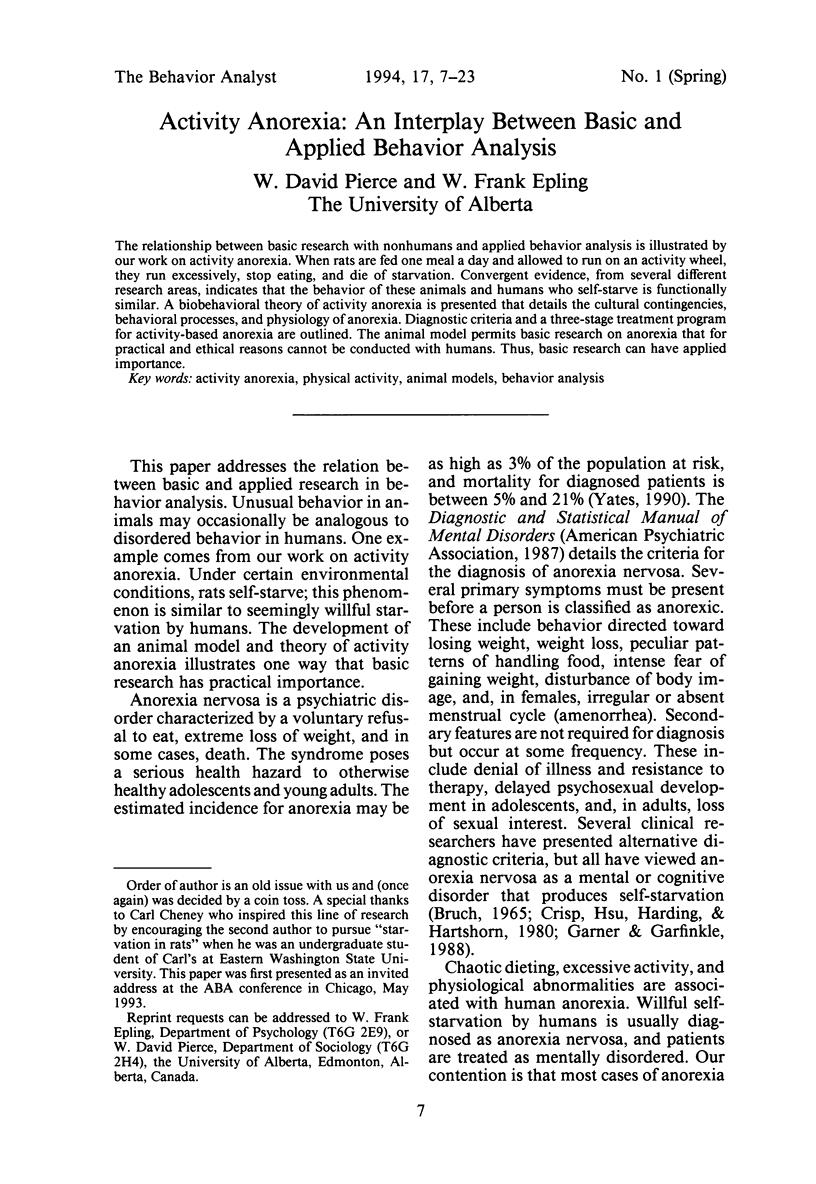
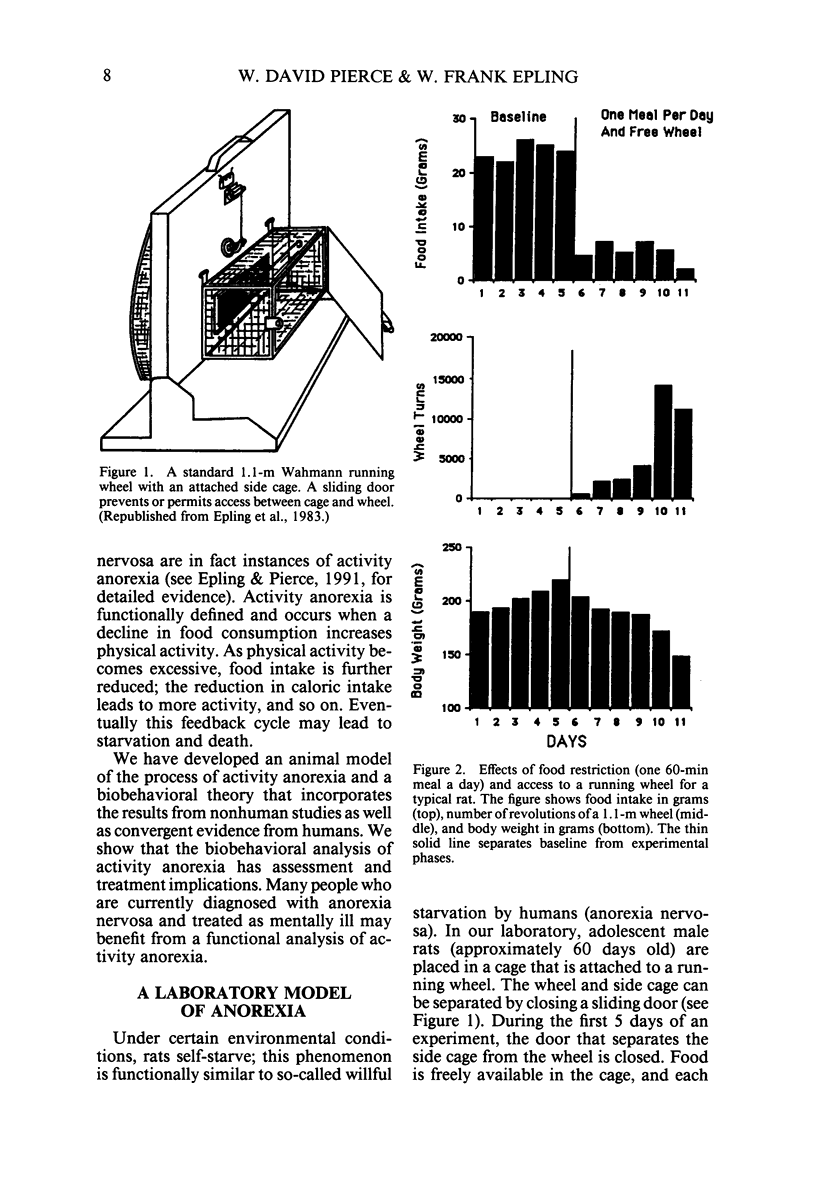
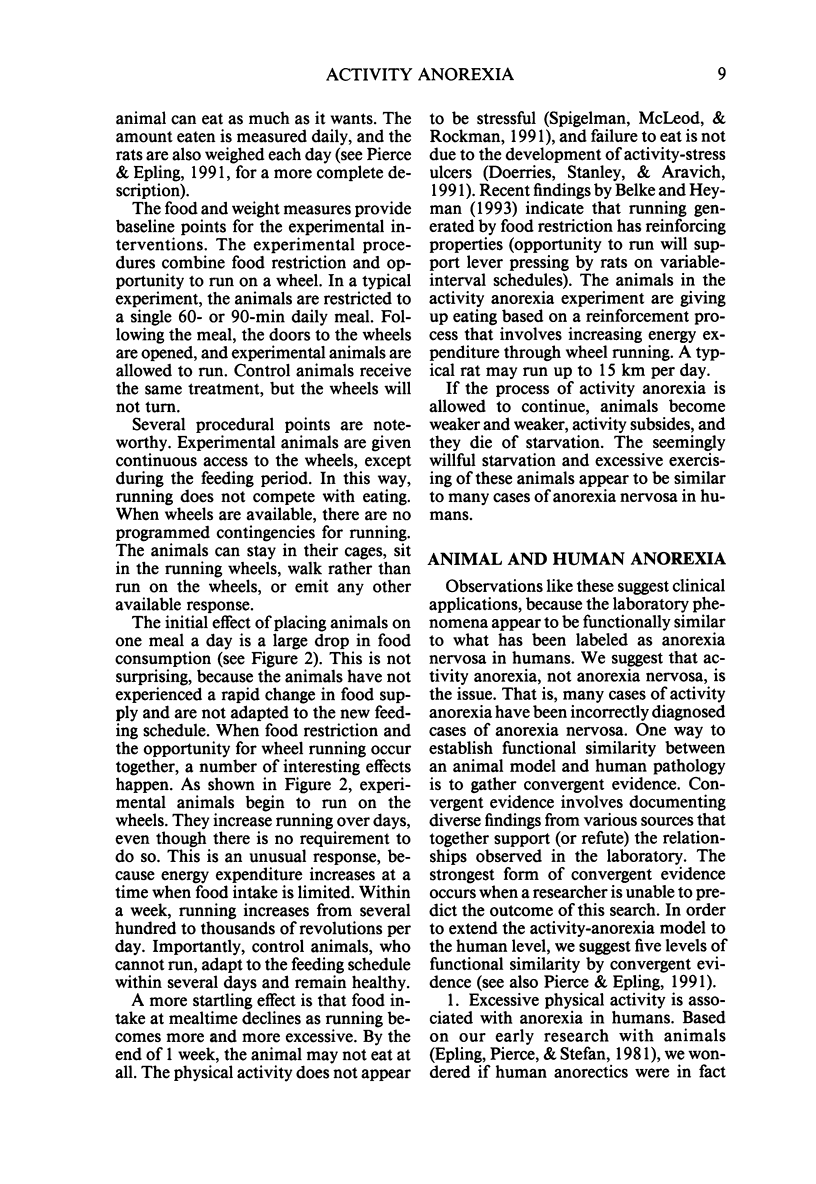
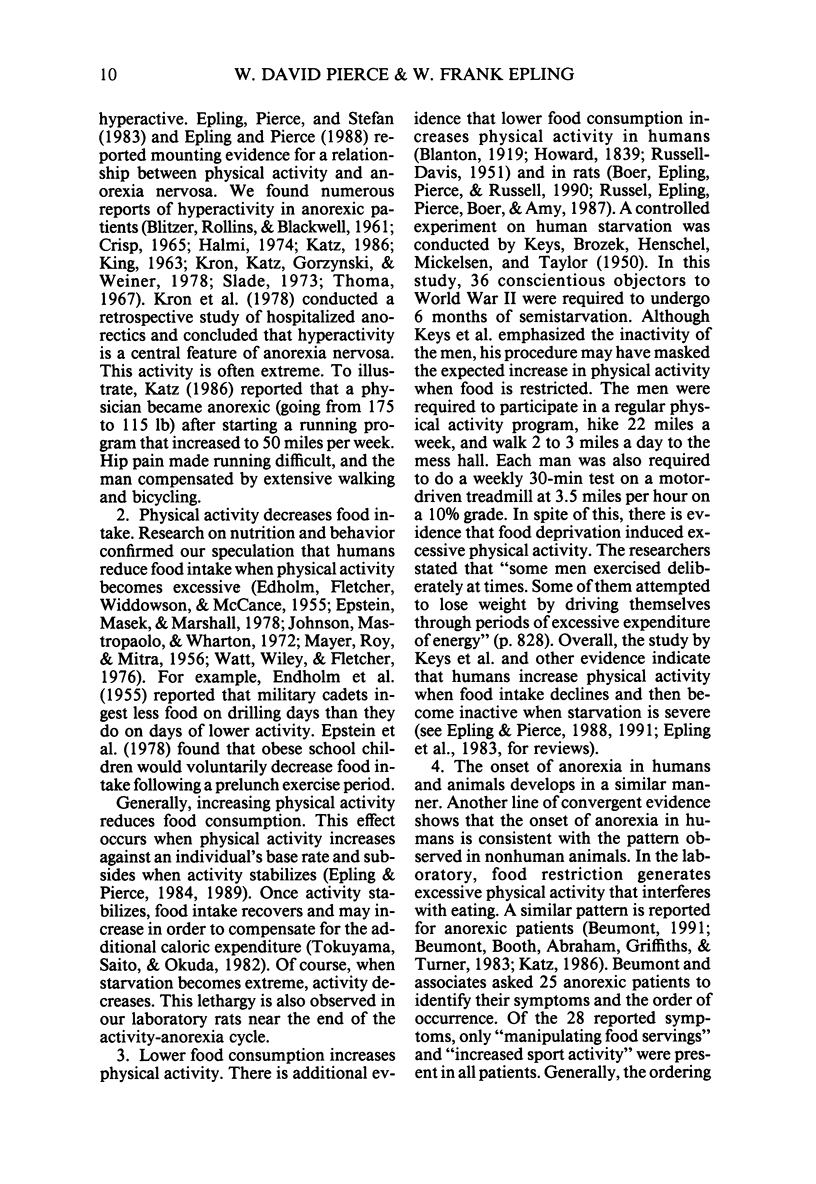
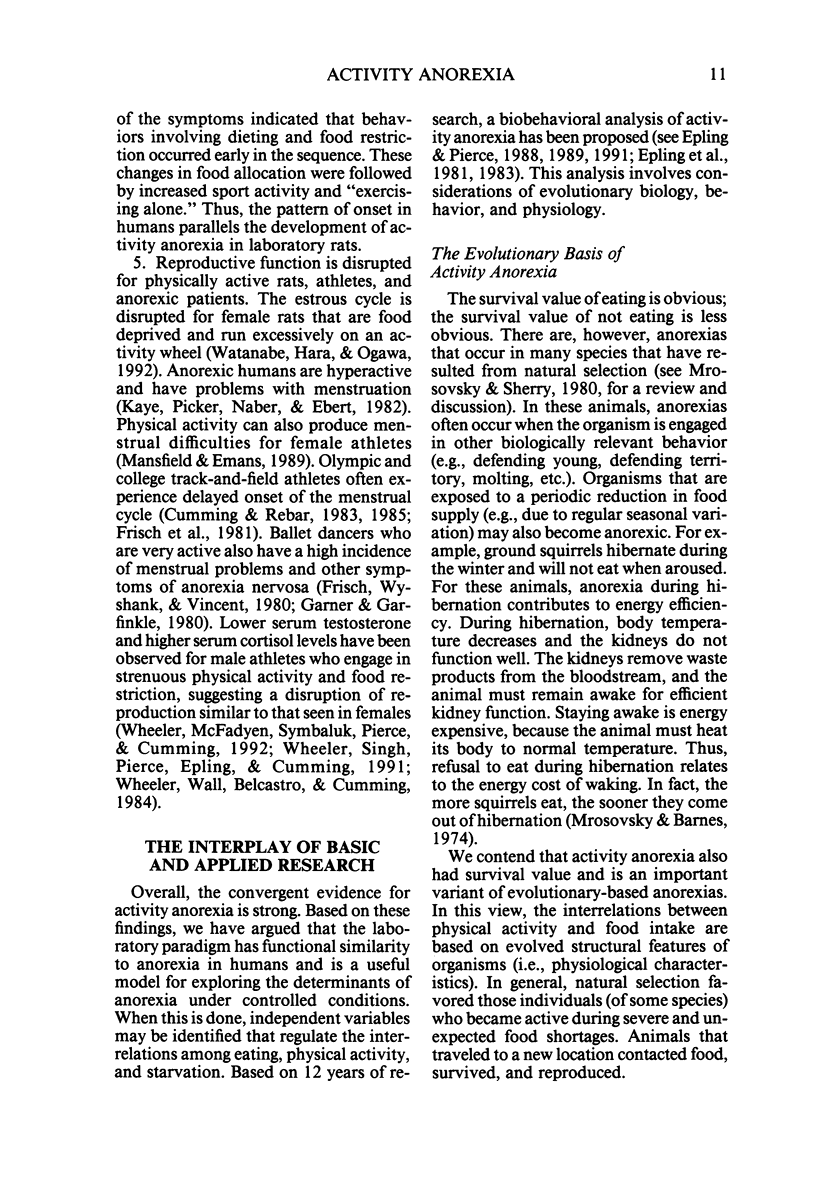
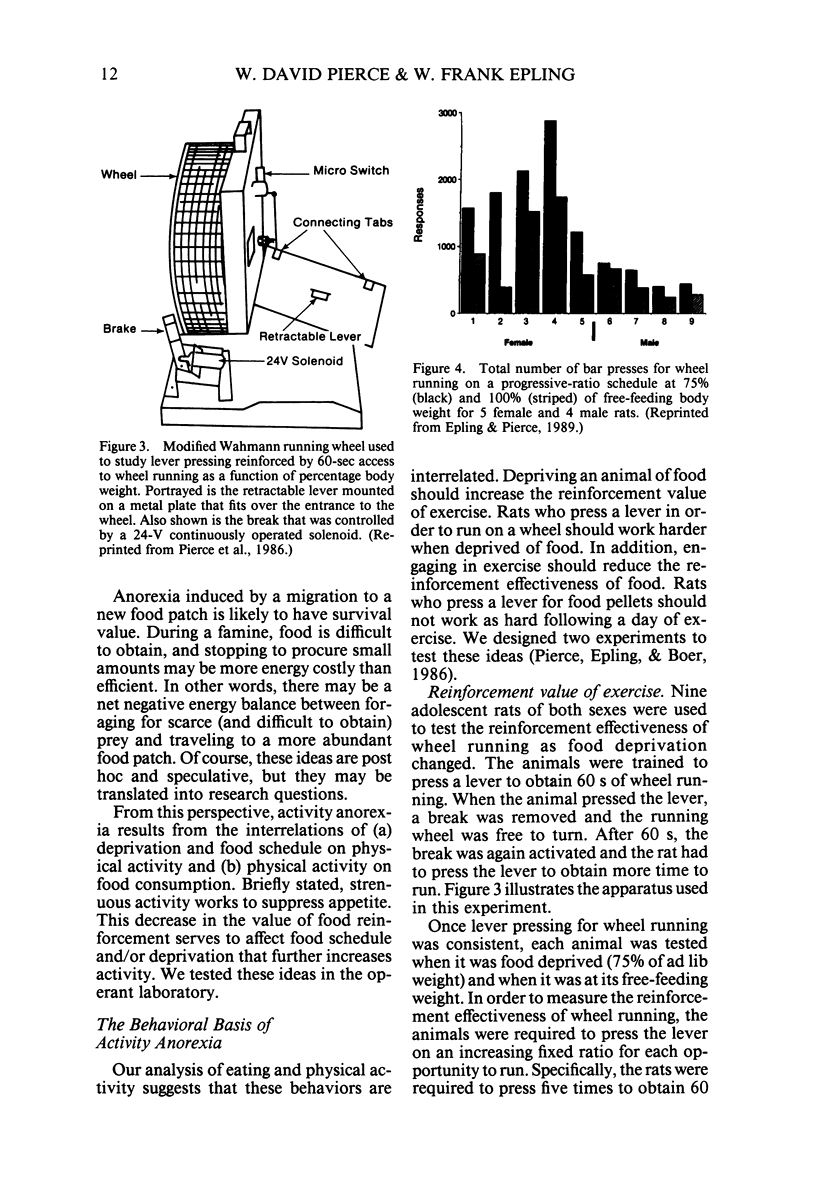
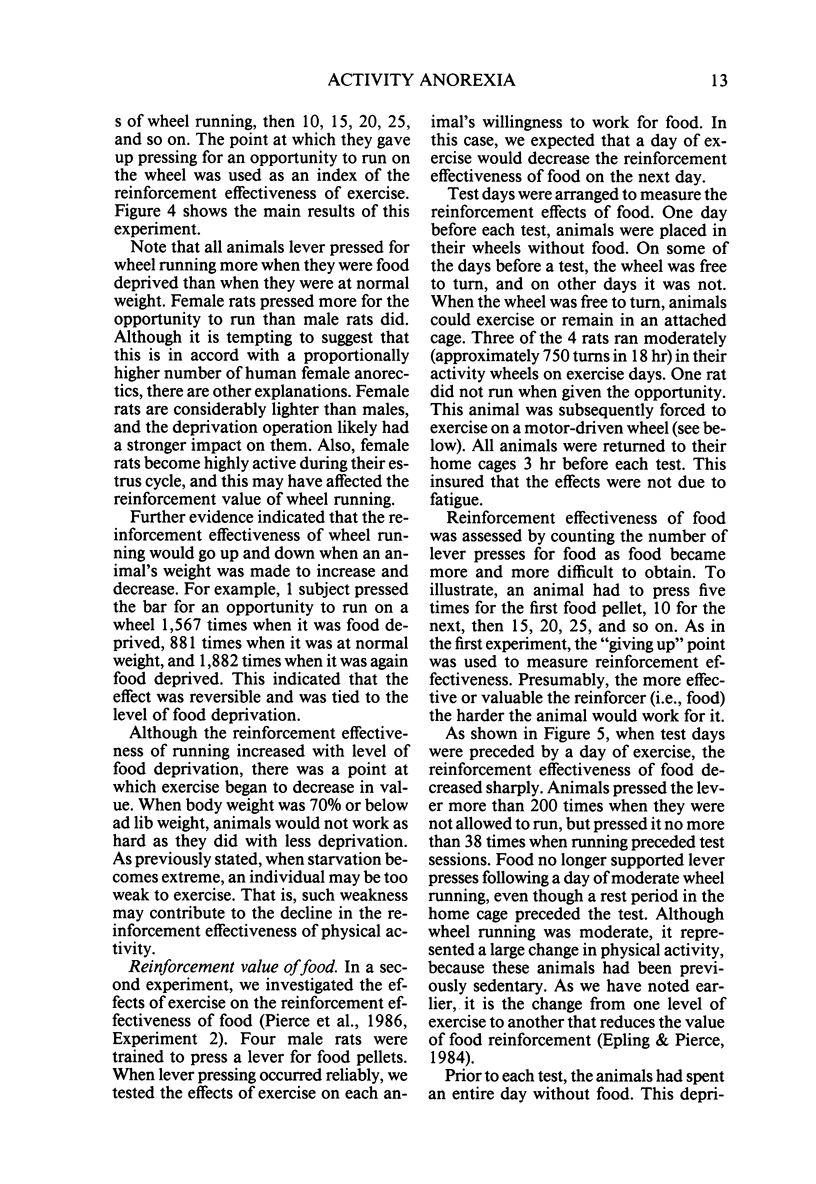
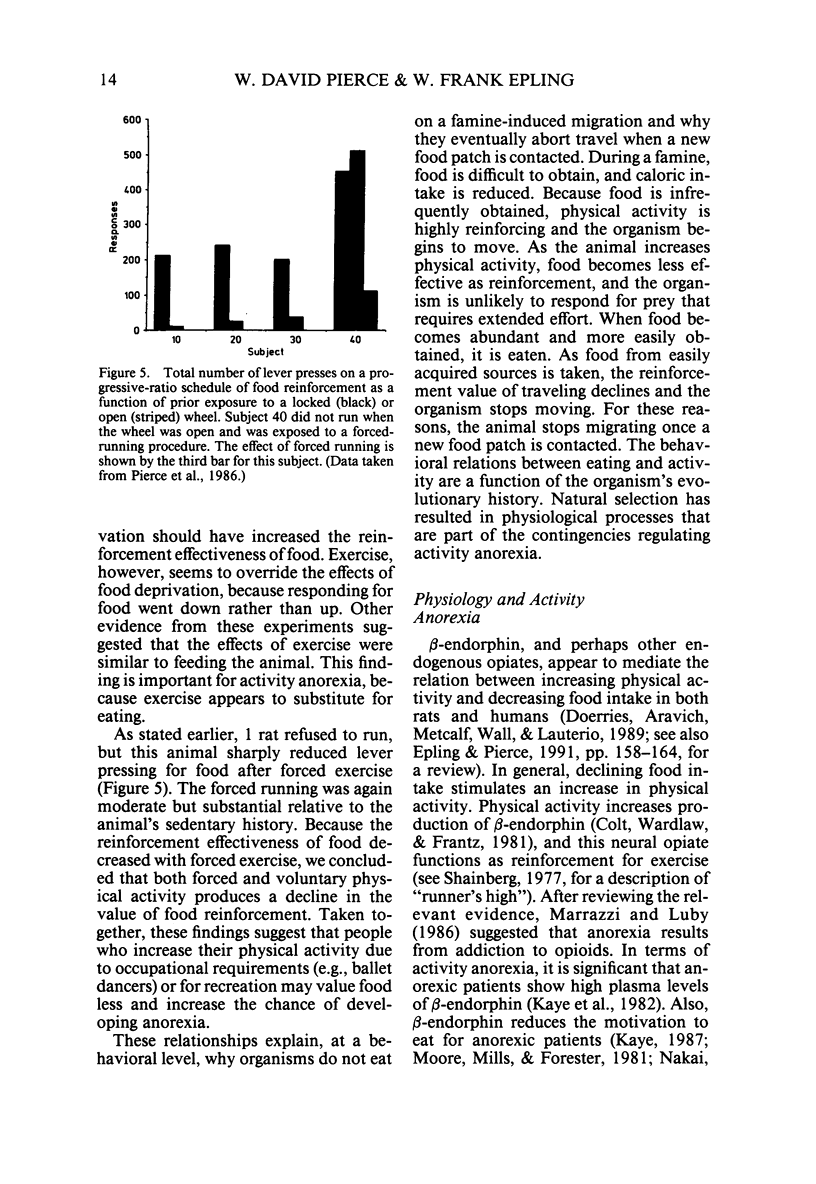
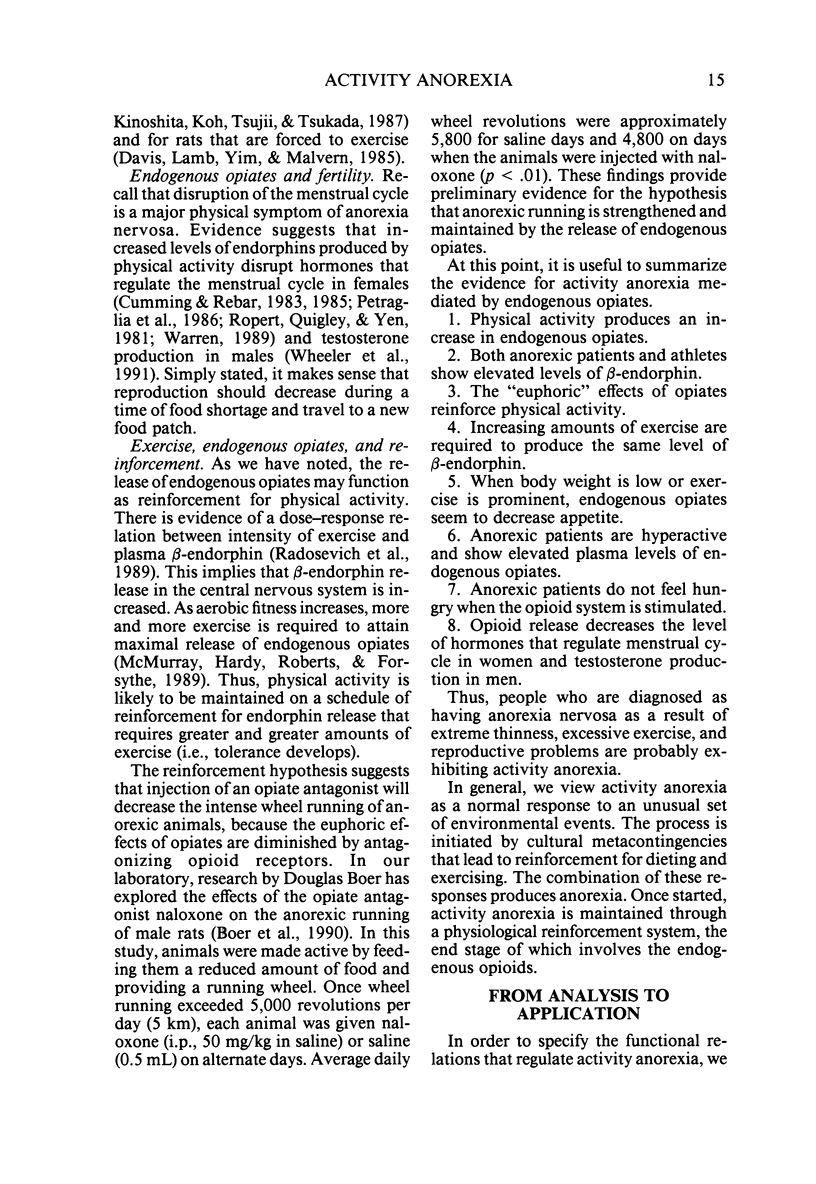
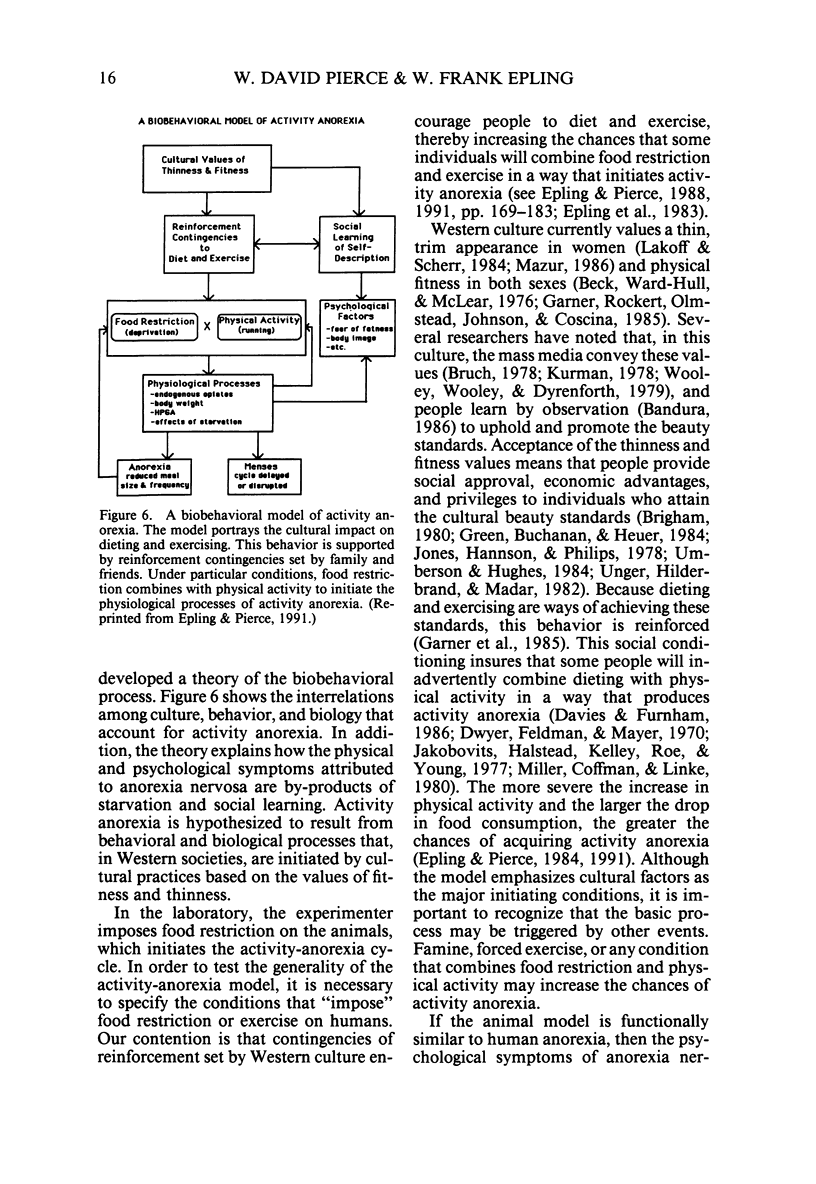
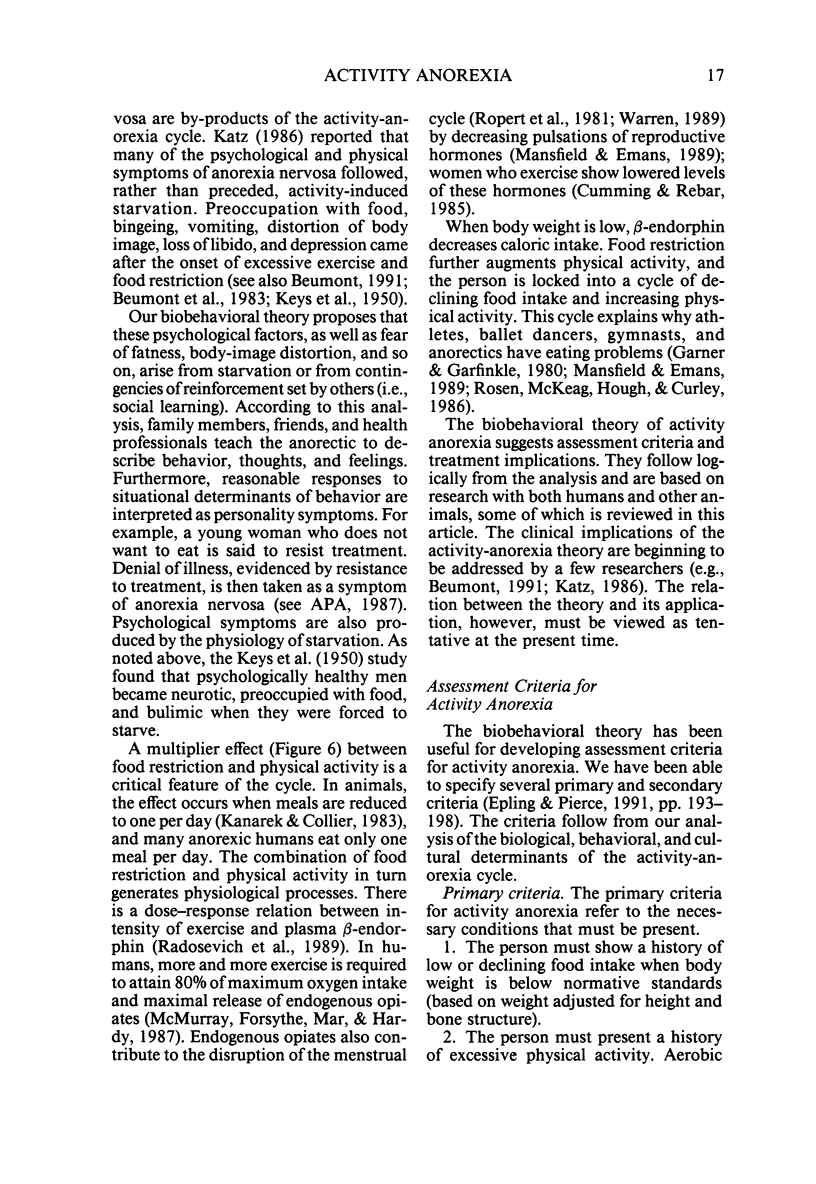
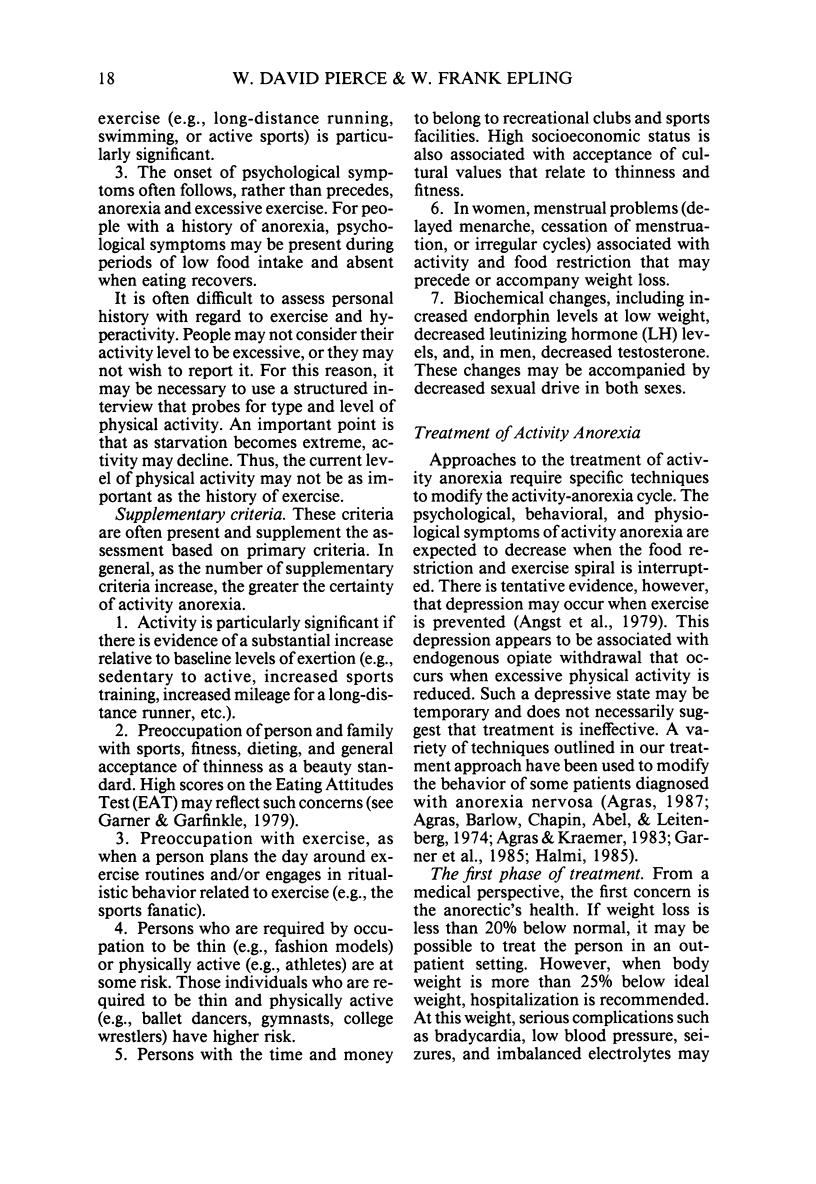
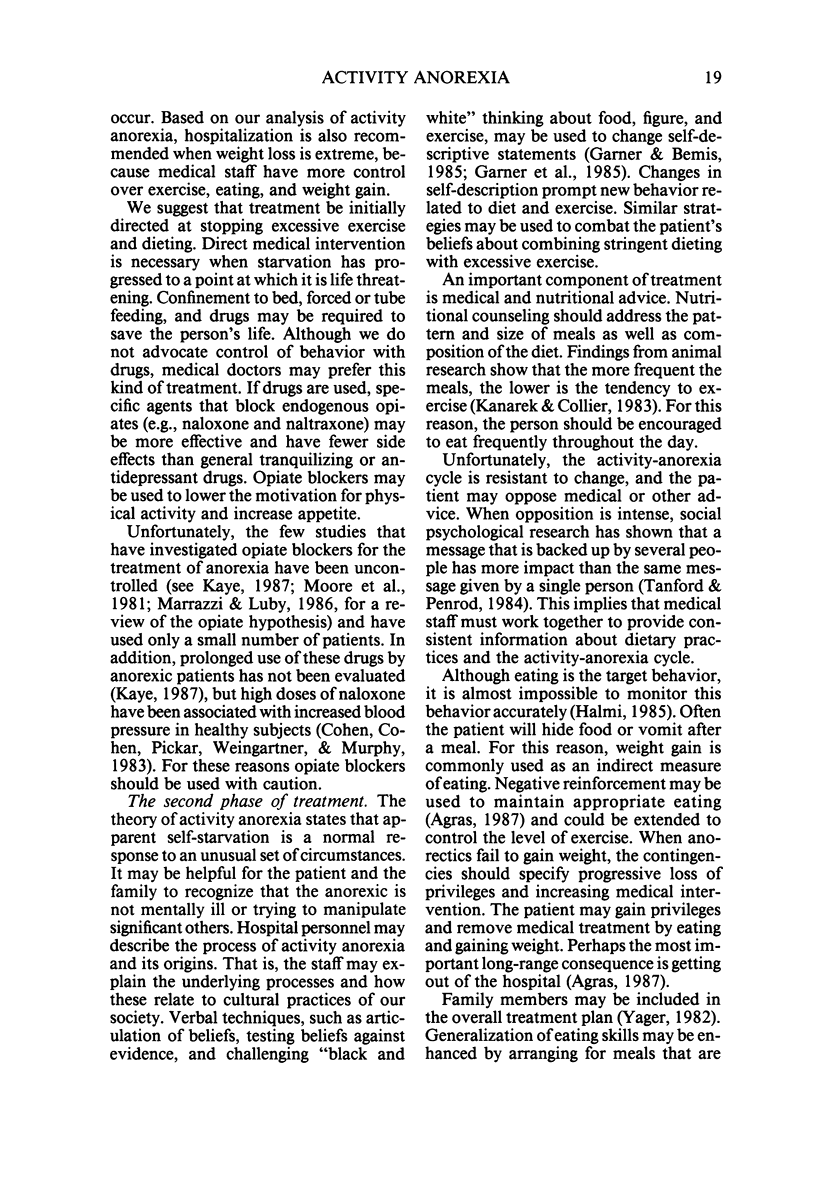
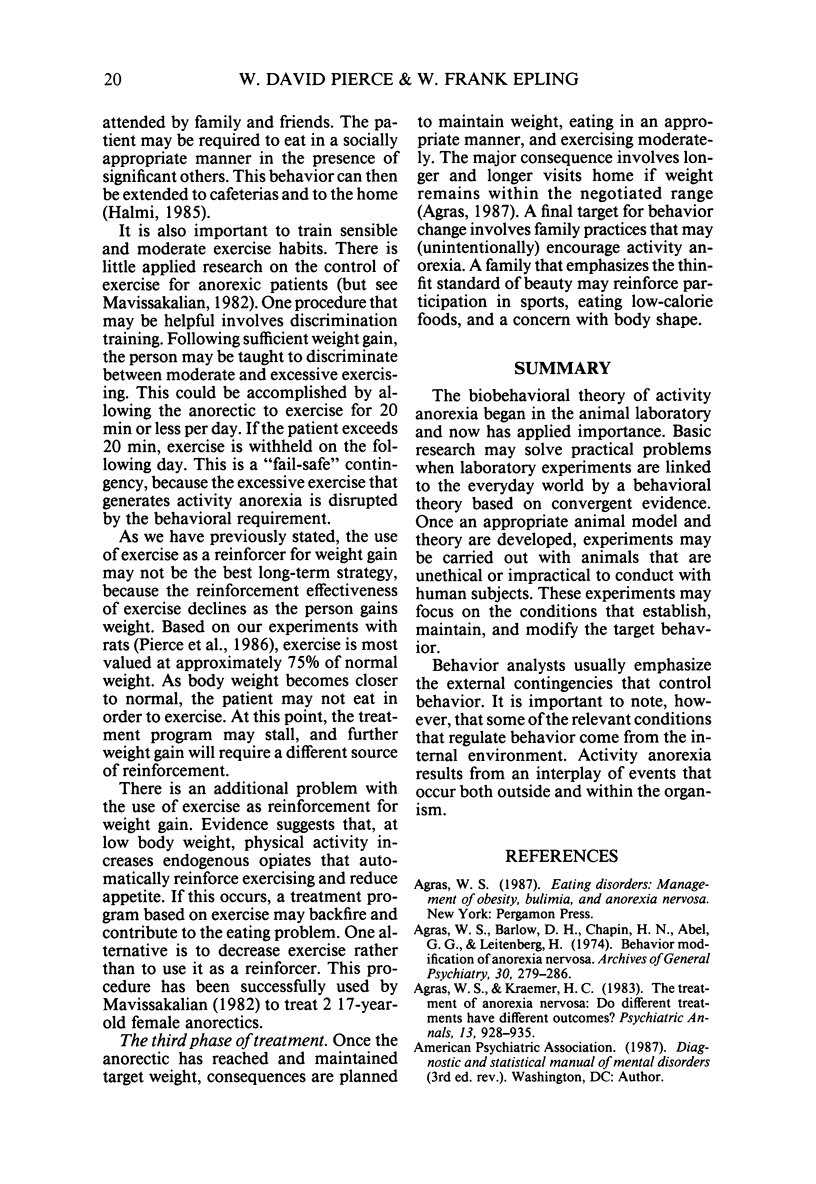
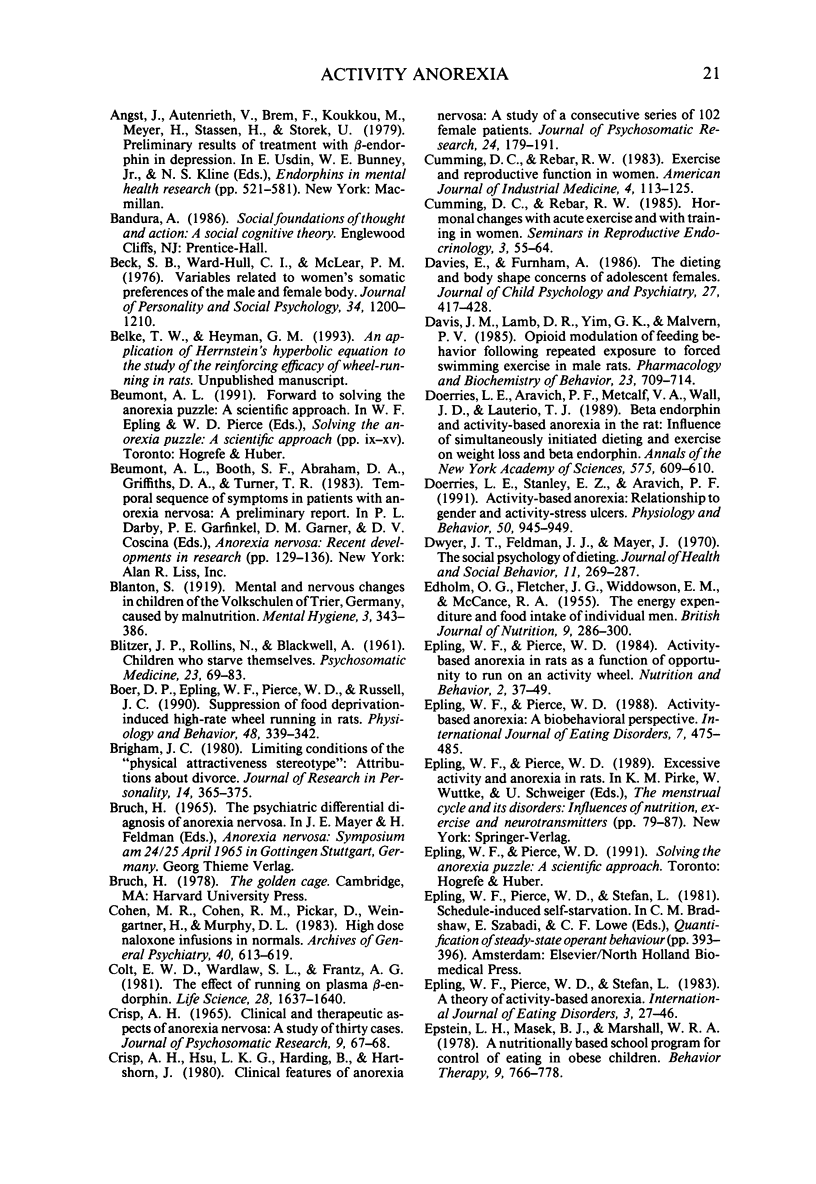
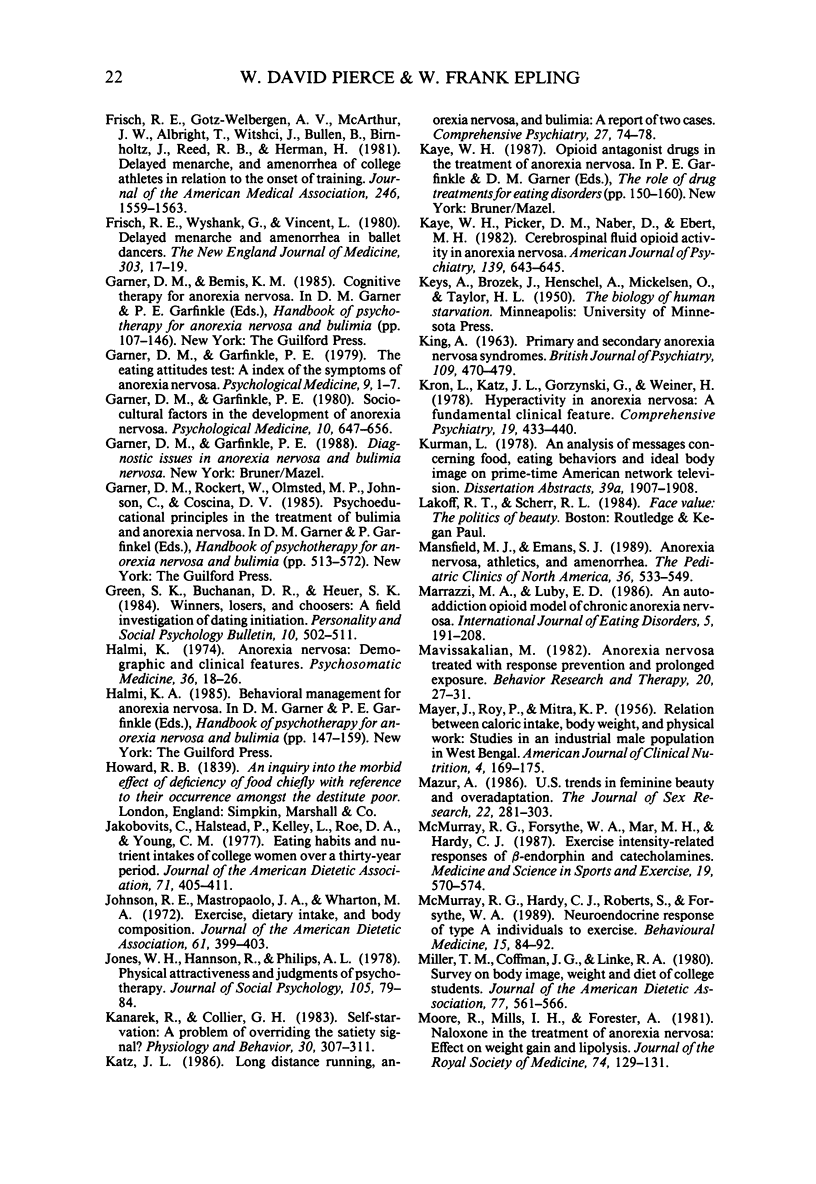
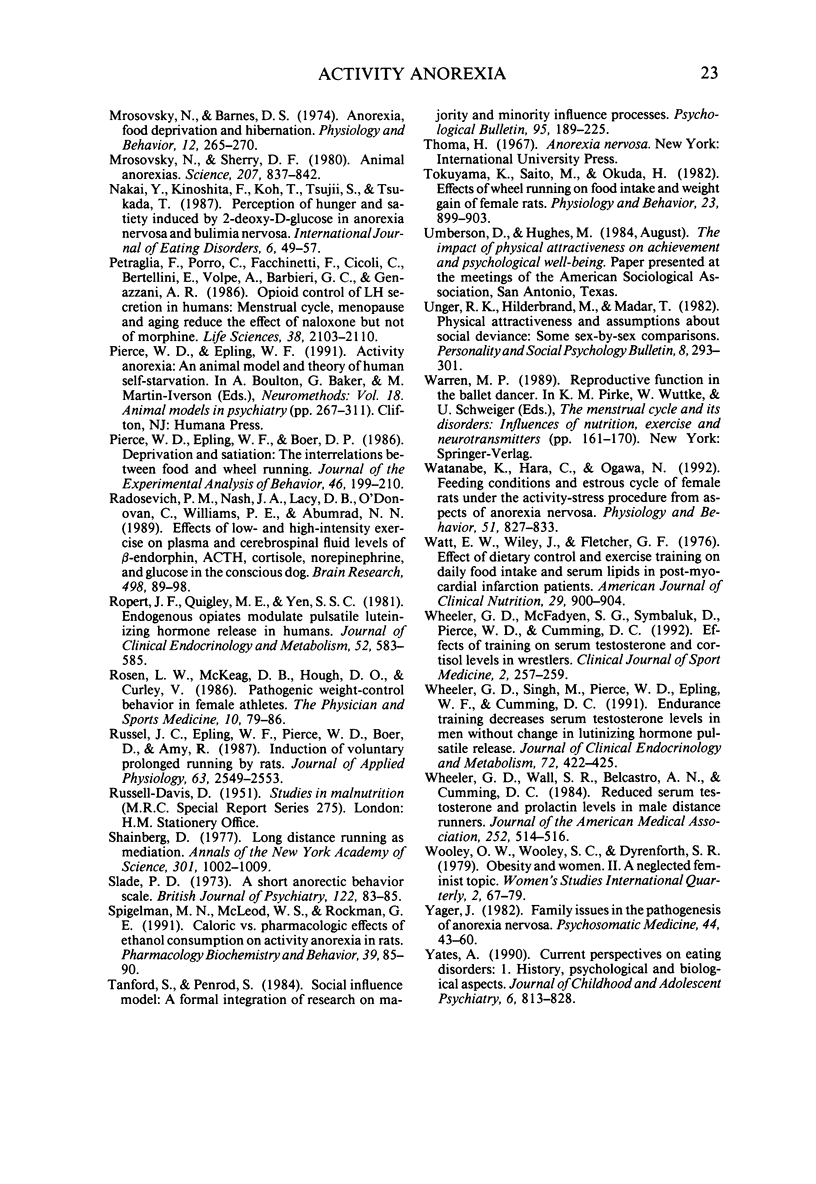
Selected References
These references are in PubMed. This may not be the complete list of references from this article.
- Agras W. S., Barlow D. H., Chapin H. N., Abel G. G., Leitenberg H. Behavior modification of anorexia nervosa. Arch Gen Psychiatry. 1974 Mar;30(3):279–286. doi: 10.1001/archpsyc.1974.01760090003001. [DOI] [PubMed] [Google Scholar]
- Boer D. P., Epling W. F., Pierce W. D., Russell J. C. Suppression of food deprivation-induced high-rate wheel running in rats. Physiol Behav. 1990 Aug;48(2):339–342. doi: 10.1016/0031-9384(90)90324-w. [DOI] [PubMed] [Google Scholar]
- Cohen M. R., Cohen R. M., Pickar D., Weingartner H., Murphy D. L. High-dose naloxone infusions in normals. Dose-dependent behavioral, hormonal, and physiological responses. Arch Gen Psychiatry. 1983 Jun;40(6):613–619. doi: 10.1001/archpsyc.1983.04390010023003. [DOI] [PubMed] [Google Scholar]
- Colt E. W., Wardlaw S. L., Frantz A. G. The effect of running on plasma beta-endorphin. Life Sci. 1981 Apr 6;28(14):1637–1640. doi: 10.1016/0024-3205(81)90319-2. [DOI] [PubMed] [Google Scholar]
- Crisp A. H. Clinical and therapeutic aspects of anorexia nervosa--a study of 30 cases. J Psychosom Res. 1965 Sep;9(1):67–78. doi: 10.1016/0022-3999(65)90013-9. [DOI] [PubMed] [Google Scholar]
- Crisp A. H., Hsu L. K., Harding B., Hartshorn J. Clinical features of anorexia nervosa. A study of a consecutive series of 102 female patients. J Psychosom Res. 1980;24(3-4):179–191. doi: 10.1016/0022-3999(80)90040-9. [DOI] [PubMed] [Google Scholar]
- Cumming D. C., Rebar R. W. Exercise and reproductive function in women. Am J Ind Med. 1983;4(1-2):113–125. [PubMed] [Google Scholar]
- Davies E., Furnham A. The dieting and body shape concerns of adolescent females. J Child Psychol Psychiatry. 1986 May;27(3):417–428. doi: 10.1111/j.1469-7610.1986.tb01843.x. [DOI] [PubMed] [Google Scholar]
- Davis J. M., Lamb D. R., Yim G. K., Malven P. V. Opioid modulation of feeding behavior following repeated exposure to forced swimming exercise in male rats. Pharmacol Biochem Behav. 1985 Nov;23(5):709–714. doi: 10.1016/0091-3057(85)90059-0. [DOI] [PubMed] [Google Scholar]
- Doerries L. E., Stanley E. Z., Aravich P. F. Activity-based anorexia: relationship to gender and activity-stress ulcers. Physiol Behav. 1991 Nov;50(5):945–949. doi: 10.1016/0031-9384(91)90419-o. [DOI] [PubMed] [Google Scholar]
- Dwyer J. T., Feldman J. J., Mayer J. The social psychology of dieting. J Health Soc Behav. 1970 Dec;11(4):269–287. [PubMed] [Google Scholar]
- EDHOLM O. G., FLETCHER J. G., WIDDOWSON E. M., MCCANCE R. A. The energy expenditure and food intake of individual men. Br J Nutr. 1955;9(3):286–300. doi: 10.1079/bjn19550040. [DOI] [PubMed] [Google Scholar]
- Frisch R. E., Gotz-Welbergen A. V., McArthur J. W., Albright T., Witschi J., Bullen B., Birnholz J., Reed R. B., Hermann H. Delayed menarche and amenorrhea of college athletes in relation to age of onset of training. JAMA. 1981 Oct 2;246(14):1559–1563. [PubMed] [Google Scholar]
- Frisch R. E., Wyshak G., Vincent L. Delayed menarche and amenorrhea in ballet dancers. N Engl J Med. 1980 Jul 3;303(1):17–19. doi: 10.1056/NEJM198007033030105. [DOI] [PubMed] [Google Scholar]
- Garner D. M., Garfinkel P. E. Socio-cultural factors in the development of anorexia nervosa. Psychol Med. 1980 Nov;10(4):647–656. doi: 10.1017/s0033291700054945. [DOI] [PubMed] [Google Scholar]
- Halmi K. A. Anorexia nervosa: demographic and clinical features in 94 cases. Psychosom Med. 1974 Jan-Feb;36(1):18–26. doi: 10.1097/00006842-197401000-00002. [DOI] [PubMed] [Google Scholar]
- Jakobovits C., Halstead P., Kelley L., Roe D. A., Young C. M. Eating habits and nutrient intakes of college women over a thirty-year period. J Am Diet Assoc. 1977 Oct;71(4):405–411. [PubMed] [Google Scholar]
- Johnson R. E., Mastropaolo J. A., Wharton M. A. Exercise, dietary intake, and body composition. J Am Diet Assoc. 1972 Oct;61(4):399–403. [PubMed] [Google Scholar]
- Jones W. H., Hansson R. O., Phillips A. L. Physical attractiveness and judgments of psychopathology. J Soc Psychol. 1978 Jun;105(FIRST):79–84. doi: 10.1080/00224545.1978.9924093. [DOI] [PubMed] [Google Scholar]
- KING A. Primary and secondary anorexia nervosa syndromes. Br J Psychiatry. 1963 Jul;109:470–479. doi: 10.1192/bjp.109.461.470. [DOI] [PubMed] [Google Scholar]
- Kanarek R. B., Collier G. H. Self-starvation: a problem of overriding the satiety signal? Physiol Behav. 1983 Feb;30(2):307–311. doi: 10.1016/0031-9384(83)90024-0. [DOI] [PubMed] [Google Scholar]
- Katz J. L. Long-distance running, anorexia nervosa, and bulimia: a report of two cases. Compr Psychiatry. 1986 Jan-Feb;27(1):74–78. doi: 10.1016/0010-440x(86)90072-6. [DOI] [PubMed] [Google Scholar]
- Kaye W. H., Pickar D., Naber D., Ebert M. H. Cerebrospinal fluid opioid activity in anorexia nervosa. Am J Psychiatry. 1982 May;139(5):643–645. doi: 10.1176/ajp.139.5.643. [DOI] [PubMed] [Google Scholar]
- Kosterlitz H. W. Endogenous opioid peptides and the control of pain. Psychol Med. 1979 Feb;9(1):1–4. doi: 10.1017/s0033291700021498. [DOI] [PubMed] [Google Scholar]
- Kron L., Katz J. L., Gorzynski G., Weiner H. Hyperactivity in anorexia nervosa: a fundamental clinical feature. Compr Psychiatry. 1978 Sep-Oct;19(5):433–440. doi: 10.1016/0010-440x(78)90072-x. [DOI] [PubMed] [Google Scholar]
- MAYER J., ROY P., MITRA K. P. Relation between caloric intake, body weight, and physical work: studies in an industrial male population in West Bengal. Am J Clin Nutr. 1956 Mar-Apr;4(2):169–175. doi: 10.1093/ajcn/4.2.169. [DOI] [PubMed] [Google Scholar]
- Mansfield M. J., Emans S. J. Anorexia nervosa, athletics, and amenorrhea. Pediatr Clin North Am. 1989 Jun;36(3):533–549. doi: 10.1016/s0031-3955(16)36684-6. [DOI] [PubMed] [Google Scholar]
- Mavissakalian M. Anorexia nervosa treated with response prevention and prolonged exposure. Behav Res Ther. 1982;20(1):27–31. doi: 10.1016/0005-7967(82)90005-5. [DOI] [PubMed] [Google Scholar]
- McMurray R. G., Forsythe W. A., Mar M. H., Hardy C. J. Exercise intensity-related responses of beta-endorphin and catecholamines. Med Sci Sports Exerc. 1987 Dec;19(6):570–574. [PubMed] [Google Scholar]
- McMurray R. G., Hardy C. J., Roberts S., Forsythe W. A., Mar M. H. Neuroendocrine responses of type A individuals to exercise. Behav Med. 1989 Summer;15(2):84–92. doi: 10.1080/08964289.1989.9935156. [DOI] [PubMed] [Google Scholar]
- Miller T. M., Coffman J. G., Linke R. A. Survey on body image, weight, and diet of college students. J Am Diet Assoc. 1980 Nov;77(5):561–566. [PubMed] [Google Scholar]
- Moore R., Mills I. H., Forster A. Naloxone in the treatment of anorexia nervosa: effect on weight gain and lipolysis. J R Soc Med. 1981 Feb;74(2):129–131. doi: 10.1177/014107688107400208. [DOI] [PMC free article] [PubMed] [Google Scholar]
- Mrosovsky N., Barnes D. S. Anorexia, food deprivation and hibernation. Physiol Behav. 1974 Feb;12(2):265–270. doi: 10.1016/0031-9384(74)90181-4. [DOI] [PubMed] [Google Scholar]
- Mrosovsky N., Sherry D. F. Animal anorexias. Science. 1980 Feb 22;207(4433):837–842. doi: 10.1126/science.6928327. [DOI] [PubMed] [Google Scholar]
- Petraglia F., Porro C., Facchinetti F., Cicoli C., Bertellini E., Volpe A., Barbieri G. C., Genazzani A. R. Opioid control of LH secretion in humans: menstrual cycle, menopause and aging reduce effect of naloxone but not of morphine. Life Sci. 1986 Jun 9;38(23):2103–2110. doi: 10.1016/0024-3205(86)90209-2. [DOI] [PubMed] [Google Scholar]
- Pierce W. D., Epling W. F., Boer D. P. Deprivation and satiation: The interrelations between food and wheel running. J Exp Anal Behav. 1986 Sep;46(2):199–210. doi: 10.1901/jeab.1986.46-199. [DOI] [PMC free article] [PubMed] [Google Scholar]
- Radosevich P. M., Nash J. A., Lacy D. B., O'Donovan C., Williams P. E., Abumrad N. N. Effects of low- and high-intensity exercise on plasma and cerebrospinal fluid levels of ir-beta-endorphin, ACTH, cortisol, norepinephrine and glucose in the conscious dog. Brain Res. 1989 Sep 25;498(1):89–98. doi: 10.1016/0006-8993(89)90402-2. [DOI] [PubMed] [Google Scholar]
- Ropert J. F., Quigley M. E., Yen S. S. Endogenous opiates modulate pulsatile luteinizing hormone release in humans. J Clin Endocrinol Metab. 1981 Mar;52(3):583–585. doi: 10.1210/jcem-52-3-583. [DOI] [PubMed] [Google Scholar]
- Russell J. C., Epling W. F., Pierce D., Amy R. M., Boer D. P. Induction of voluntary prolonged running by rats. J Appl Physiol (1985) 1987 Dec;63(6):2549–2553. doi: 10.1152/jappl.1987.63.6.2549. [DOI] [PubMed] [Google Scholar]
- Slade P. D. A short anorexic behaviour scale. Br J Psychiatry. 1973 Jan;122(566):83–85. doi: 10.1192/bjp.122.1.83. [DOI] [PubMed] [Google Scholar]
- Spigelman M. N., McLeod W. S., Rockman G. E. Caloric vs. pharmacologic effects of ethanol consumption on activity anorexia in rats. Pharmacol Biochem Behav. 1991 May;39(1):85–90. doi: 10.1016/0091-3057(91)90401-m. [DOI] [PubMed] [Google Scholar]
- Tokuyama K., Saito M., Okuda H. Effects of wheel running on food intake and weight gain of male and female rats. Physiol Behav. 1982 May;28(5):899–903. doi: 10.1016/0031-9384(82)90211-6. [DOI] [PubMed] [Google Scholar]
- Watanabe K., Hara C., Ogawa N. Feeding conditions and estrous cycle of female rats under the activity-stress procedure from aspects of anorexia nervosa. Physiol Behav. 1992 Apr;51(4):827–832. doi: 10.1016/0031-9384(92)90122-i. [DOI] [PubMed] [Google Scholar]
- Watt E. W., Wiley J., Fletcher G. F. Effect of dietary control and exercise training on daily food intake and serum lipids in postmyocardial infarction patients. Am J Clin Nutr. 1976 Aug;29(8):900–904. doi: 10.1093/ajcn/29.8.900. [DOI] [PubMed] [Google Scholar]
- Wheeler G. D., Singh M., Pierce W. D., Epling W. F., Cumming D. C. Endurance training decreases serum testosterone levels in men without change in luteinizing hormone pulsatile release. J Clin Endocrinol Metab. 1991 Feb;72(2):422–425. doi: 10.1210/jcem-72-2-422. [DOI] [PubMed] [Google Scholar]
- Wheeler G. D., Wall S. R., Belcastro A. N., Cumming D. C. Reduced serum testosterone and prolactin levels in male distance runners. JAMA. 1984 Jul 27;252(4):514–516. [PubMed] [Google Scholar]
- Yager J. Family issues in the pathogenesis of anorexia nervosa. Psychosom Med. 1982 Mar;44(1):43–60. doi: 10.1097/00006842-198203000-00007. [DOI] [PubMed] [Google Scholar]


